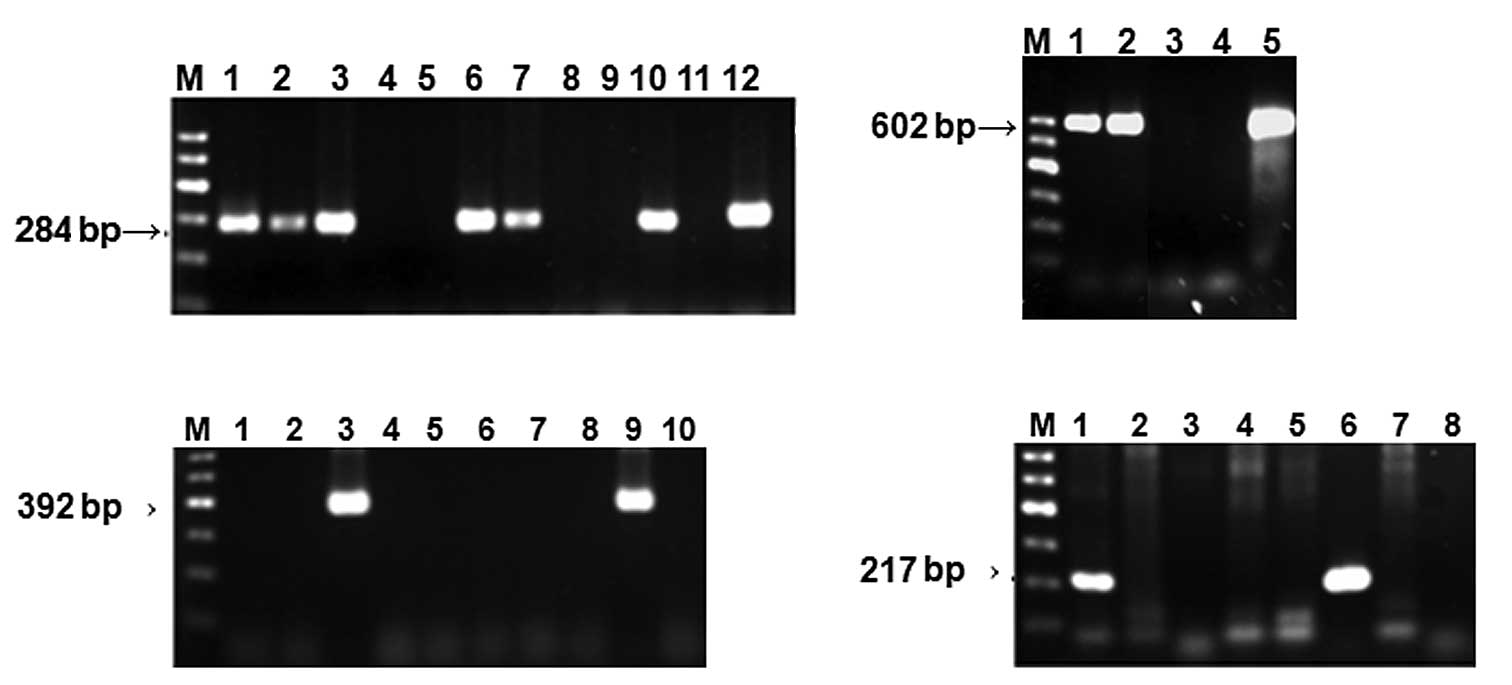|
1
|
Ozawa K and Young NS: Characterization of
capsid and noncapsid proteins of B19 parvovirus propagated in human
erythroid bone marrow culture. J Virol. 61:2627–2630.
1987.PubMed/NCBI
|
|
2
|
Bultmann BD, Klingel K, Sotlar K, et al:
Parvovirus B19: a pathogen responsible for more than hematologic
disorders. Virchows Arch. 442:8–17. 2003.PubMed/NCBI
|
|
3
|
Anderson MJ, Higgins PG, Davis LR, et al:
Experimental parvoviral infection in humans. J Infect Dis.
152:257–265. 1985. View Article : Google Scholar : PubMed/NCBI
|
|
4
|
Kelleher JF, Luban NL, Mortimer PP and
Kamimura T: Human serum parvovirus: a specific cause of aplastic
crisis in children with hereditary spherocytosis. J Pediatr.
102:720–722. 1983. View Article : Google Scholar : PubMed/NCBI
|
|
5
|
Pattison JR, Jones SE, Hodgson J, et al:
Parvovirus infections and hypoplastic crisis in sickle-cell anemia.
Lancet. 317:664–665. 1981. View Article : Google Scholar : PubMed/NCBI
|
|
6
|
Reid DM, Reid TM, Brown T, et al: Human
parvovirus associated arthritis: a clinical and laboratory
description. Lancet. 325:422–425. 1985. View Article : Google Scholar
|
|
7
|
Kinney JS, Anderson LJ, Farrar J, et al:
Risk of adverse outcomes of pregnancy after human parvovirus B
infection. J Infect Dis. 7:663–667. 1988. View Article : Google Scholar : PubMed/NCBI
|
|
8
|
Torok TJ: Unusual clinical manifestations
reported in patients with parvovirus B19 infection. Monogr.
20:61–92. 1997.
|
|
9
|
Ahsan N, Holman MJ, Gocke CD, et al: Pure
red cell aplasia due to parvovirus B19 infection in solid organ
transplantation. Clin Transpl. 11:265–270. 1997.PubMed/NCBI
|
|
10
|
Chernak E, Dubin G, Henry D, et al:
Infection due to parvovirus B19 in patients infected with human
immunodeficiency virus. Clin Infect Dis. 20:170–173. 1995.
View Article : Google Scholar : PubMed/NCBI
|
|
11
|
Kurtzman GJ, Ozawa K, Cohen B, et al:
Chronic bone marrow failure due to persistent B19 parvovirus
infection. N Engl J Med. 317:287–294. 1987. View Article : Google Scholar : PubMed/NCBI
|
|
12
|
Allander T, Tammi MT, Eriksson M, et al:
Cloning of a human parvovirus by molecular sereening of respiratory
tract samples. Proc Natl Acad Sci USA. 102:12891–12898. 2005.
View Article : Google Scholar : PubMed/NCBI
|
|
13
|
Allander T: Human bocavirus. J Clin Virol.
41:29–33. 2008. View Article : Google Scholar
|
|
14
|
Lindner J, Karalar L, Schimanski S, et al:
Clinical and epidemiological aspects of human bocavirus infection.
J Clin Virol. 43:391–395. 2008. View Article : Google Scholar : PubMed/NCBI
|
|
15
|
Tozer SJ, Lambert SB, Whiley DM, et al:
Detection of human bocavirus in respiratory, fecal, and blood
samples by real-time PCR. J Med Virol. 81:488–493. 2009. View Article : Google Scholar : PubMed/NCBI
|
|
16
|
Fry AM, Lu X, Chittaganpitch M, et al:
Human bocavirus: a novel parvovirus epidemiologically associated
with pneumonia requiring hospitalization in Thailand. J Infect Dis.
195:1038–1045. 2007. View
Article : Google Scholar : PubMed/NCBI
|
|
17
|
Allander T, Jartti T, Gupta S, et al:
Human bocavirus and acute wheezing in children. Clin Infect Dis.
44:904–910. 2007. View
Article : Google Scholar : PubMed/NCBI
|
|
18
|
Neske F, Blessing K, Tollmann F, et al:
Real-time PCR for diagnosis of human bocavirus infections and
phylogenetic analysis. J Clin Microbiol. 45:2116–2122. 2007.
View Article : Google Scholar : PubMed/NCBI
|
|
19
|
Vicente D, Cilla G, Montes M, et al: Human
bocavirus, a respiratory and enteric virus. Emerg Infect Dis.
13:636–637. 2007. View Article : Google Scholar : PubMed/NCBI
|
|
20
|
Pozo F, García-García ML, Calvo C, et al:
High incidence of human bocavirus infection in children in Spain. J
Clin Virol. 40:224–228. 2007. View Article : Google Scholar : PubMed/NCBI
|
|
21
|
Kesebir D, Vazquez M, Weibel C, et al:
Human bocavirus infection in young children in the United States:
molecular epidemiological profile and clinical characteristics of a
newly emerging respiratory virus. J Infect Dis. 194:1276–1282.
2006. View
Article : Google Scholar
|
|
22
|
Maggi F, Andreoli E, Pifferi M, et al:
Human bocavirus in Italian patients with respiratory diseases. J
Clin Virol. 38:321–325. 2007. View Article : Google Scholar : PubMed/NCBI
|
|
23
|
García-García ML, Calvo C, Pozo F, et al:
Human bocavirus detection in nasopharyngeal aspirates of children
without clinical symptoms of respiratory infection. Pediatr Infect
Dis J. 27:358–360. 2008.PubMed/NCBI
|
|
24
|
Wang K, Wang W, Yan H, et al: Correlation
between bocavirus infection and humoral response, and co-infection
with other respiratory viruses in children with acute respiratory
infection. J Clin Virol. 47:148–155. 2010. View Article : Google Scholar : PubMed/NCBI
|
|
25
|
Young NS: Parvoviruses. Fields Virology.
Knipe DM and Howley PM: 3rd edition. Lippincott, Williams and
Wilkins; Philadelphia, USA: pp. 2199–2220. 1996
|
|
26
|
Kurtzman GJ, Cohen BJ, Field AM, et al:
Immune response to B19 parvovirus and an antibody defect in
persistent viral infection. J Clin Invest. 84:1114–1123. 1989.
View Article : Google Scholar : PubMed/NCBI
|
|
27
|
Sung HK, Lin LI, Chang CJ, et al:
Increased risk of parvovirus B19 infection in young adult cancer
patients receiving multiple courses of chemotherapy. J Clin
Microbiol. 40:3909–3912. 2002. View Article : Google Scholar : PubMed/NCBI
|















